These Islands Are Like Hawaii But Without the Crowds
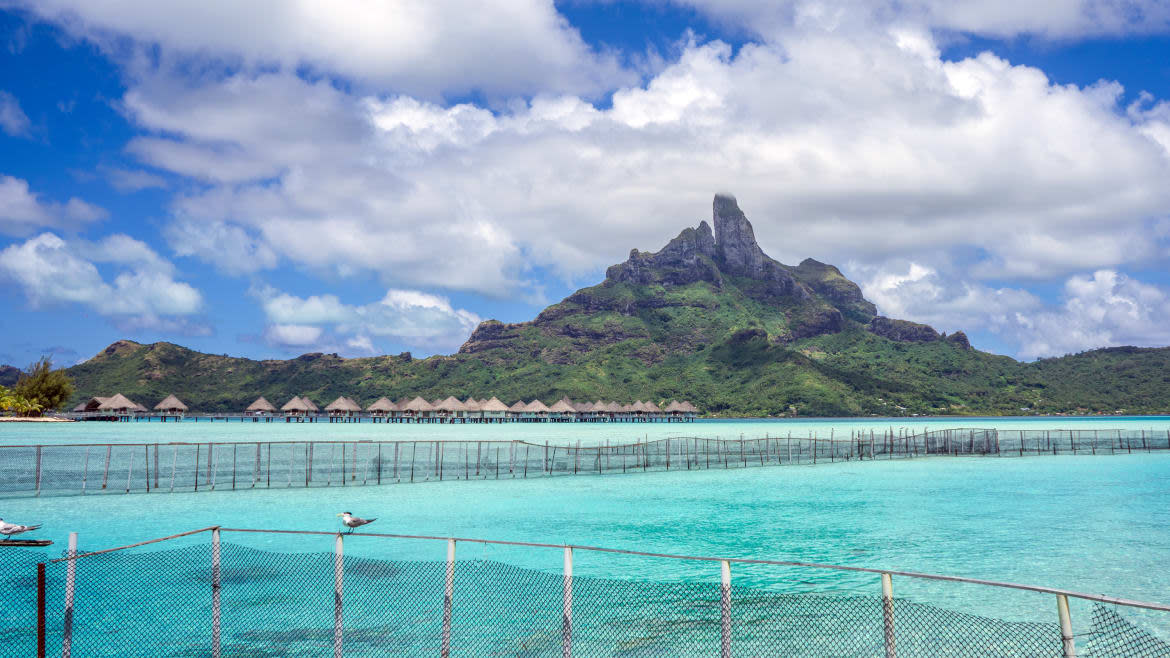
This is the latest in our series on underrated destinations, It’s Still a Big World.
Nothing will ruin a vacation quite like crowds. Whether it’s beaches and bars or museums and mountaintops, large groups of tourists often make a visit more difficult, annoying, and expensive. Don’t get me wrong, I had a great time in Hawaii and it’s definitely one of the most beautiful places on earth, but the more I travel and the older I get, the less tolerant I am of crowds (and the more I begin sounding like my grandfather, apparently).
As such, I jumped at the chance to visit French Polynesia, which receives fewer tourists in an entire year than Hawaii receives in a single day. Where did I get this fun fact? From virtually every tour guide and hotel representative I met in French Polynesia, actually. This comparison seemed a bit far-fetched so I figured someone started a rumor on the islands that everyone picked up on so I decided to fact-check it. Sure enough, they were right. Last June, the Hawaiian Islands received 265,157 visitors per day while the Islands of Tahiti received about 230,000 visitors throughout the year.
First off, let’s break down the idea of French Polynesia for a second. The Polynesian triangle encompasses over 1,000 islands and 300,000 square miles, extending from Hawaii (the northern tip) to New Zealand (the southwestern tip) and over to Easter Island (the southeastern tip). French Polynesia is smack dab in the middle of the triangle and consists of five archipelagos and 118 islands. French Polynesia was colonized by the French (surprise!) and covers the same approximate continental area as all of Europe. Yes, you read that correctly.
French Polynesia is a diverse mix of islands that cover an enormous area but Americans often incorrectly refer to the country—“collectivity,” really (thanks, France!)—simply as Tahiti. Tahiti is the largest island in French Polynesia and it holds about half its population, but Tahiti and French Polynesia are not one and the same.
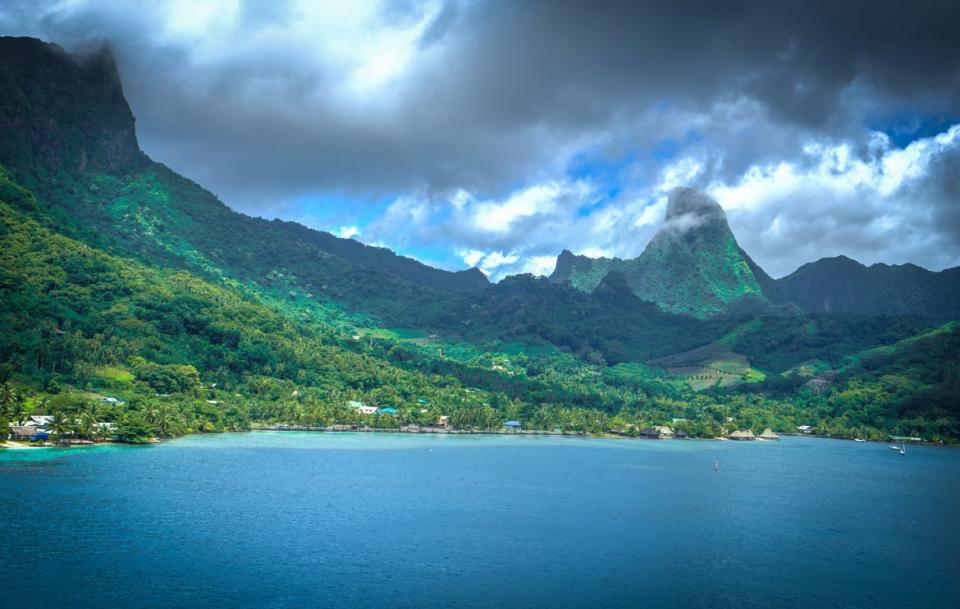
Bora Bora.
Bora Bora
Until 1941, visitors didn’t really go to French Polynesia, but this changed when Japan attacked Hawaii, and the U.S. entered World War II. The U.S. wanted to set up a refueling base in the Pacific for military convoys making their way from Panama to Australia and almost overnight, French Polynesia’s Teavanui Pass was dynamited and a base popped up on Bora Bora. At the time, Bora Bora didn’t have an airport and there wasn’t ferry service between the islands so pretty much nobody was traveling there (now, numerous ferries are moving between different islands).
Between 1942 and 1946, approximately 5,000 American soldiers were stationed in Bora Bora. When the U.S. military packed up and left without warning, all these soldiers left the island, leaving behind many new single mothers. Once back in the U.S., GIs began to spread the word about how gorgeous French Polynesia was. Because Bora Bora suddenly had a brand-new airport and wide roads thanks to the military base, it was now possible for tourists to begin making their way to and around the islands.
Each of the islands in French Polynesia is autonomous in how it runs tourism; some islands have been turning down developer projects year after year while Bora Bora has long been very commercial. Despite this, it remains uncrowded, and many of its hotels specialize in private, above-water bungalows that offer a luxurious escape from both crowds and the usual resort experience.
I stayed at the InterContinental Bora Bora Resort and Thalasso Spa, which, I can say, without a doubt, is the most incredible hotel I’ve stayed at. My above-water villa was spacious and modern, with luxurious amenities like a deep soak tub overlooking the ocean and a private balcony where I could relax on a lounge chair or jump into the water to snorkel. The coolest feature, however, had to be the illuminated glass-bottom viewing box in the living room that allowed me to peer down into the water to look for fish. Though the scuba diving, snorkeling, and motu (tiny, sometimes private, island) picnics around Bora Bora are all fantastic, the highlight of my visit was a trip to the hotel’s Thalasso Spa.
The resort is very sustainably minded, and pioneered the Sea Water Air Conditioning technique, which pulls cold water from deep in the ocean to power the air conditioners. Considering a huge chunk of resort energy consumption (and expenses) in hot and humid areas like French Polynesia can be attributed to air conditioning, the significance of this discovery cannot be understated. Instead of using fresh water, ocean-pumped water is used in the spa’s cold plunge pools, soaking tubs, and water therapy treatments. I booked a treatment that consisted of a relaxing Polynesian taurumi massage using locally sourced oils while natural ocean water rained down onto me. Hands down, this was one of the best massages I’ve ever had in my life. I enjoyed the spa’s tea lounge, sauna, and open-air Jacuzzis so much that I spent two afternoons here.
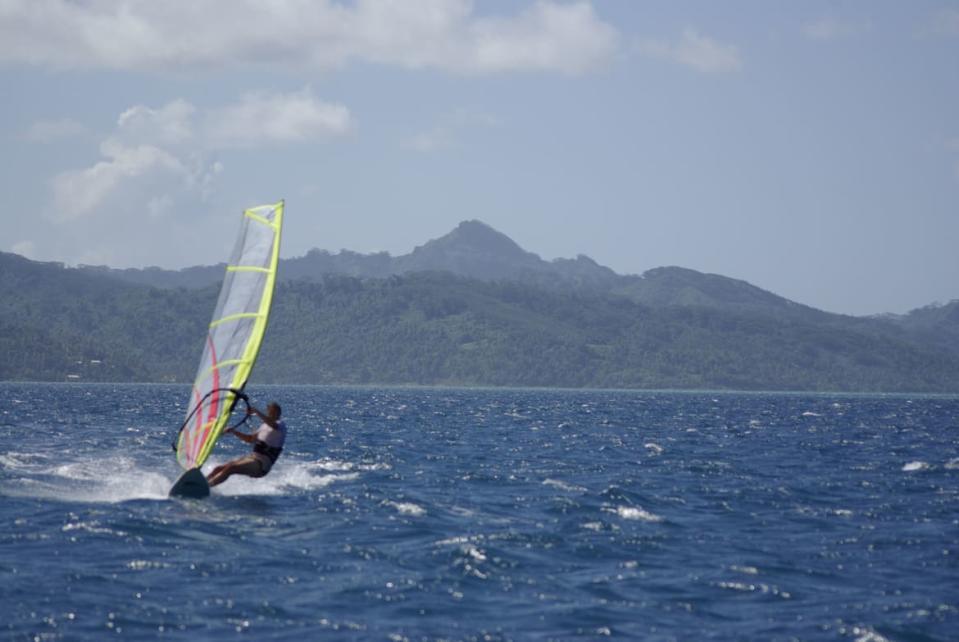
Raiatea.
Raiatea
If I had to choose one island to return to, it would probably be Raiatea. Not only is it home to the center of Polynesian civilization, but Raiatea has a little bit of everything so there’s something for everyone (hit up Raiatea Culture Tour for history and culture tours led by local expert and Renaissance Man Giovanni). Unlike the huge hotels you’ll find in Tahiti, Raiatea only has very small hotels and homestays, so it also has a much more relaxed vibe. I stayed at the Raiatea Lodge, which is set on a gorgeous waterfront estate and provides kayaks and bicycles to guests looking to fill downtime that’s not otherwise spent lounging at the pool or on their private balcony.
In Raiatea, you can go hiking, biking, scuba diving, snorkeling, swimming, kayaking, shopping, ATVing, and boating. But no matter what, make sure you book a day trip to Tahaa, which is a quick boat ride away. I spent the day visiting pearl farms, rum distilleries, and vanilla plantations with Terainui Tours, and it was probably the best day of my trip (after my Bora Bora massage, that is). After the island tour, I was whisked off to a private motu island picnic before visiting several snorkeling locations so I could swim with black-tip reef sharks and stingrays and then snorkel through a massive coral garden.
While “Tahitian” vanilla may be one of the most famous vanillas in the world, about 70 percent of it actually comes from Tahaa. Even though it wasn’t prime vanilla harvesting season during my visit, I still enjoyed touring the area, seeing the pods grow, smelling them dry in the sun, and purchasing some excellent (and very expensive) vanilla pods to take home. What made them worth the $10/pod price tag? The instructions the farm gave me to make my own vanilla extract at home, which I expect will pay for itself in time!
After spending a day’s wages at the vanilla farm, we headed for a tour of Pari Pari rum distillery which also gives an interesting tour and allows you to sample your way through their top sellers. By the way, they also sell the best natural exfoliating soap I’ve ever used in my life. If you go, please buy me 10 more bars and I’ll Venmo you back!
Next up was the Iaorana Pearl Farm, which I’ll admit to having zero interest in visiting but I didn’t want to be rude and ask my guide to skip. Thank goodness I was polite because, while I have no personal interest in owning or wearing pearls, the tour was thoroughly fascinating, as helpful staff explained the years-long and labor-intensive pearl farming process. I also got to see up-close the meticulous practice of grafting pearls and inserting in bits of DNA from well-performing oysters in order to artificially create scars that will (hopefully) eventually create a mother of pearl.
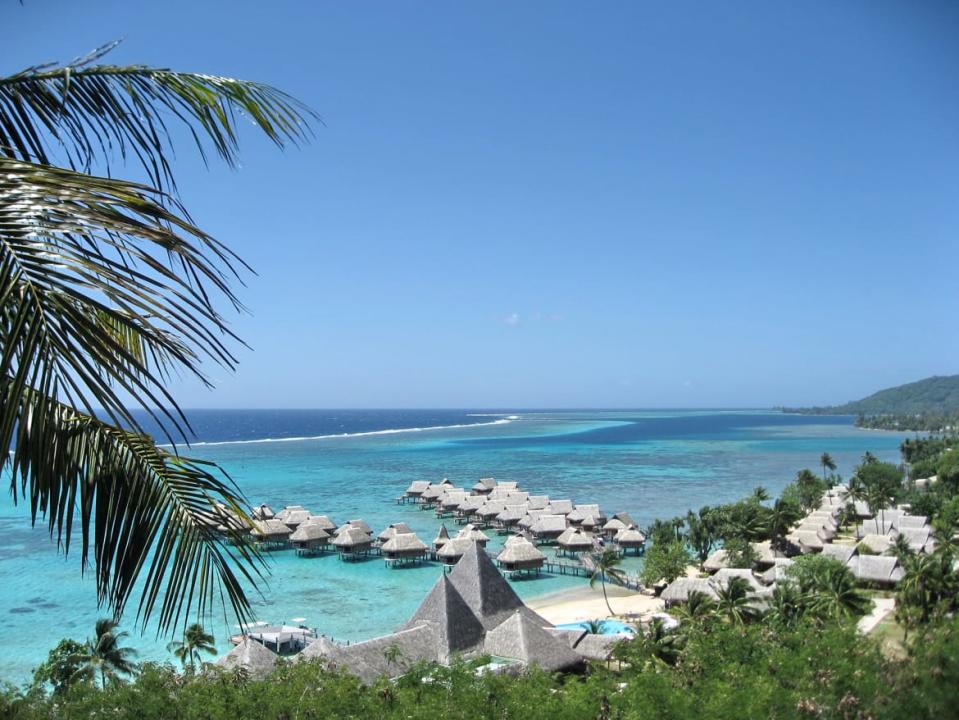
Moorea.
Moorea
Though the island of Tahiti is said to have the best hiking in all of French Polynesia, it would have been too time-consuming for me to venture to the hiking region given the rest of my itinerary so I opted for several hikes on Moorea with a company called Moorea By Foot. The hikes were challenging and rewarding and the scenery was stunning, but the real treat was my guide, Te Aurahi, an aboriginal New Zealander who moved to Moorea about twenty years ago “to marry a Tahitian princess.”
Te Aurahi picked me up at the ferry terminal and drove us to the supermarket so he could pick up a new pair of plastic sandals for hiking. You know those “jelly” sandals with the flimsy clip that were so popular in the ’80s? Yeah, those. He swore up and down that they’re the best hiking shoes for the wet, slippery conditions yet I doubted him until we arrived on the trail.
The rainy season starts in mid-December, right when I visited, so the muddy mountain trails were slippery, to say the least. Te Aurahi planted his jelly sandals firmly on the trail and held my hand to help me and my apparently inadequate Tevas up and down sketchy stretches. Note that access to some hiking areas around the islands is only granted if you’re accompanied by a guide but even if you are hiking in areas that don’t require a guide, it’s still wise to go with a local. Plants grow fast here and trails often become overgrown. In several cases, Te Aurahi not only pointed out the correct route (which I absolutely would have missed had I been on my own), but he also bushwhacked branches out of the way for us to pass more comfortably.
Tourists routinely run out of water or food, slip and fall, get lost, or they injure themselves in some other way that could have easily been prevented. In the event that I injured myself at the top of a steep, slippery mountain, I was happy to know that my jelly sandal-wearing guide’s backpack was stuffed with water, snacks, ropes, tools, and emergency first aid equipment that he was highly trained to deploy.
Both of the hikes I did with Te Aurahi were incredible, but the highlight of my time with him in Moorea was the dinner I shared at his home with him and his wife, the “Polynesian Princess” he met during a visit here when he was five and who he went on to marry when he returned in his twenties. French Polynesia is not known for vegetarian food, so I was delighted to find that his wife prepared an incredible coconut jackfruit curry for me. What did we wash it down with? Traditional Polynesian kombucha, of course. The couple has actually built a pretty incredible treehouse behind their own mountainside jungle home that they recently began renting out to travelers. If you don’t mind a few stairs, it very well could be the most unique accommodations you’ll find on the island, complete with ocean views, an outdoor shower, and easy access to waterfall-studded hiking trails.
If you visit Moorea, which is a quick 30-minute ferry ride away from Tahiti, be sure to visit the Fara Natura science center, which has impressive and extensive displays about French Polynesia’s geography, geology, and biodiversity. Several immersive experiences also do an excellent job of conveying what it’s like to scuba dive, so it’s a nice opportunity for water and wildlife lovers who aren’t certified scuba divers.
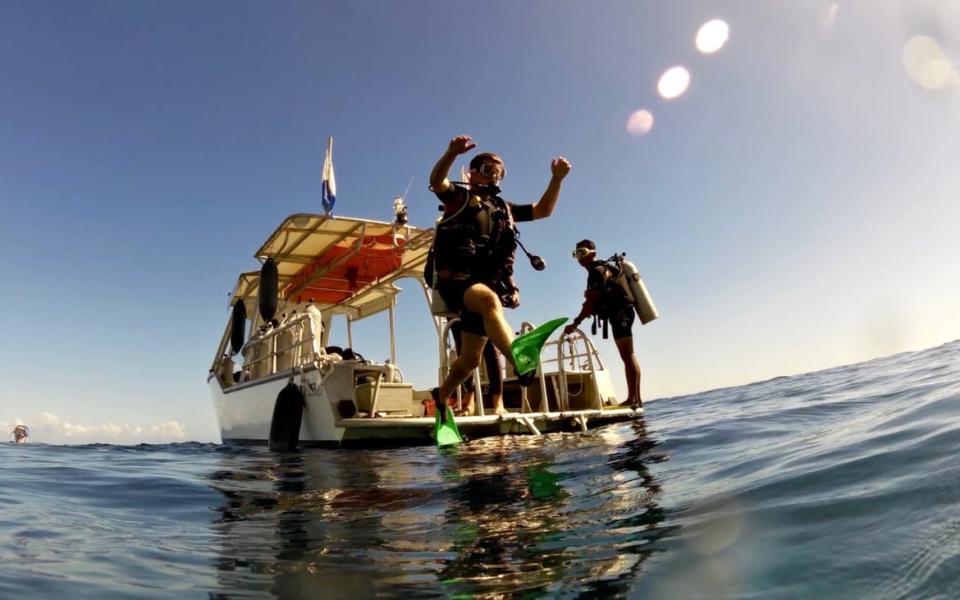
Scuba diving in French Polynesia.
Scuba Diving in French Polynesia
French Polynesia is extremely popular with scuba divers and the airline Air Tahiti Nui (which offers direct flights from Los Angeles and Seattle), even allows scuba divers to check a separate dive equipment bag free of charge. The absolute best diving here is found around islands that are several hours away by flight, but there are excellent diving opportunities on pretty much every island, so it should be very easy to work something into your trip regardless of which islands you want to visit. Even the quick dive I did just offshore near Tahiti’s capital, Papetee, was unique; I swam into a shipwreck and sat at a computer desk, putzing around on an old Macbook that was sunk for a film set years ago.
If you’re not a certified diver, you can still see sharks, turtles, and sting rays while snorkeling, but since I’m certified with PADI (the Professional Association of Diving Instructors), I was able to do deeper dives and see moray eels and manta rays with 10-foot wingspans. It’s not every day that you can see an animal the size of an elephant float past you underwater so if you’re not already a certified diver, French Polynesia would be a phenomenal place to get certified. In fact, I was the only person on the dive boat in Bora Bora that wasn’t there specifically to get their PADI Open Water Certification.
Planning Your Trip to French Polynesia
I had my assumptions about what type of travelers visit French Polynesia and, for the most part, I was wrong. Before visiting, I expected the islands to be so expensive that they would only attract wealthy honeymooners and retirees. Wrong. I met loads of travelers in their thirties and forties (and some even in their twenties) and learned that quite a few had scored serious bargains on their trips through timeshare programs and cost-saving travel clubs. Did you know Costco sells very reasonably priced vacation packages to Tahiti? I didn’t, but I met at least three couples who were extremely happy with the shockingly affordable flight, food, and hotel packages they got from this big box store turned travel agency.
I was correct, however, in assuming that single people rarely visit the islands. During my eight-day trip, I only met one other solo traveler, a British woman who happened to be sitting alone at a table next to mine on my final night. I started a conversation with her and we chatted about how lovely it had been to explore the islands alone, and she shared that she also hadn’t come across another single traveler in the three weeks she’d been there.
Whether you travel alone, with a friend or partner, or in a group, take a moment to consider how much time you’ll want to spend in French Polynesia, what your budget is, and what activities you prioritize. The vast majority of Americans only go to Bora Bora but there are a ton of amazing adventures awaiting on other islands where you’ll also get to meet a lot of European travelers, which, personally, I enjoy quite a bit. French Polynesia covers an enormous area and some of the islands are several hours from each other by flight, each of which can cost hundreds of dollars. Keep in mind, however, that many of the most popular activities (snorkeling, scuba diving, hiking, ATVing, and private motu island picnics) can be done in most places so you don’t necessarily have to visit five islands in one trip. If you do want to visit a lot of islands but want to save a few bucks, look into ferries, which may take a few more hours but could save you hundreds of dollars.
Also, while French Polynesia receives far fewer tourists than Hawaii, they do have a high season, so if you really want to avoid the crowds, plan your trip during the off-peak months. Unsurprisingly, June through August are the busiest months since so many people are off work and because this is when the islands hold all their large traditional dancing competitions and canoe races. April, May, September, and October have excellent weather but the latter two months also fall within the last half of whale-watching season, which could be a real treat. December through February are more prone to rain but if you don’t mind getting wet, you’ll find smaller crowds and lower prices.
Regardless of when you’ll go, be sure to pack sunscreen, bug spray, and—if you’ll be hiking—fashionable strappy jelly sandals so you fit in with the locals. There are a million ways to enjoy the islands and if you go to Tahaa, don’t forget to grab me some of that exfoliating soap!
Cassandra Brooklyn is a writer, travel expert, and group tour leader. She runs EscapingNY, an off-the-beaten-path travel company, and is the author of the guidebook Cuba by Bike.
Get the Daily Beast's biggest scoops and scandals delivered right to your inbox. Sign up now.
Stay informed and gain unlimited access to the Daily Beast's unmatched reporting. Subscribe now.

